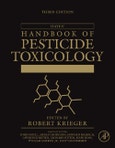The Handbook of Pesticide Toxicology is a comprehensive, two-volume reference guide to the properties, effects, and regulation of pesticides that provides the latest and most complete information to researchers investigating the environmental, agricultural, veterinary, and human-health impacts of pesticide use. Written by international experts from academia, government, and the private sector, the Handbook of Pesticide Toxicology is an in-depth examination of critical issues related to the need for, use of, and nature of chemicals used in modern pest management. This updated 3e carries on the book's tradition of serving as the definitive reference on pesticide toxicology and recognizes the seminal contribution of Wayland J. Hayes, Jr., co-Editor of the first edition.
Table of Contents
Volume 1:
1. Dose, Time and Other Factors Influencing Toxicity
2. Pest Toxicology: The Mechanisms of Pesticide Action
3. Pest Control Agents from Natural Products
4. Public Health Pesticides
5. The Changing Role of insecticides in Structural Pest Control
6. Vertebrate Pest Control Chemicals and Their Use in Urban and Rural Environments
7. Pesticide Use and Associated Morbidity and Mortality in Veterinary Medicine
8. Pesticide Use Practices in Integrated Pest Management
9. Properties of Soil Fumigants and Their Fate in the Environment
10. Risk Assessment for Acute Exposure to Pesticides
11. Genotoxicity of Pesticides
12. Developmental and Reproductive Toxicology of Pesticides
13. Microbial Pest Control Agents: Use Patterns, Registration Requirements and Mammalian Toxicity
14. The Assessment of the Chronic Toxicity and Carcinogenicity of Pesticides
15. Immunotoxicity of Pesticides
16. Risk Assessment for Acute, Subchronic and Chronic Exposure to Pesticides: Endosulfan
17. Genetic Polymorphism and Susceptibility to Pesticides
18. Pesticides as Endocrine-Disrupting Chemicals
19. Volatile Organic Compounds from Pesticide Application and Contribution to Tropospheric Ozone
20. Environmental Transport and Fate
21. Proteomics in Pesticide Toxicology
22. Metabolomics in Pesticide Toxicology
23. Irritant Dermatitis Syndrome
24. Photoirritation
25. Allergic Contact Dermatitis
26. Contact Urticaria Syndrome
27. Percutaneous Penetration
28. Regulatory Evaluation of the Skin Effects of Pesticides
29. Neurotoxicology of Pesticides
30. A Systems Biology Approach to Assess the Impact of Pesticides on the Nervous System
31. Neurophysiological Effects of Insecticides
32. Age and Pesticide Toxicity: The Influence of Age on Pesticide Toxicity
33. Lasting Behavioral Consequences of Organophosphate Pesticide Exposure During Development
34. The Nonhuman Primate as a Translational Model for Pesticide Research
35. Pesticide Disposition
36. Introduction to Biotransformation
37. Absorption
38. Metabolism of Pesticides
39. Distribution and Pharmacokinetics
40. Metabolic Interactions of Pesticides
41. Pesticide Excretion
42. Exposure Framework
43. Sampling and Analysis for Non-Occupational Pesticide Exposure Assessments
44. Modelling and Predicting Pesticide Exposures
45. Biomonitoring: Current Tools and Approaches for Assessing Human Exposures to Pesticides
46. Pesticide Exposure from Residential and Recreational Turf
47. Lawn and Turf: Management and Environmental Issues of Turfgrass Pesticides
48. Pet Care Products Used for Insect Pest Control
49. Residential Exposure Assessment
50. Modeling Dietary Exposure with Special Sections on Modeling Aggregate and Cumulative Exposure
51. Modeling Dietary Exposure with Special Sections on Modeling Aggregate and Cumulative Exposure
52. Worker Exposure: Methods and Techniques
53. Operator and Field Worker Occupational Exposure Databases and Modeling
54. Mitigation Measures for Exposure to Pesticides
55. Regional and Global Environmental Exposure Assessments Section Introduction
56. Ecotoxicological Risk Assessment of Pesticides the Environment
57. Environmental Transport and Fate
58. Hydrophobicity as a Key Physicochemical Parameter of Environmental Toxicology of Pesticides (Fujita et al.)
59. Pesticide Studies in Humans
60. Diagnosis and Treatment of Poisoning Due to Pesticides
61. Surveillance of Pesticide-Related Illness and Injury in Humans
62. Risk Assessment and Risk Management: The Regulatory Process
63. Perceptions of Pesticides as Risks to Human Health
Volume 2:
64. Chemistry of Organophosphorus Insecticides
65. The Metabolism of Organophosphorus Insecticides
66. Organophosphorus Insecticide Pharmacokinetics
67. Neuropathy Target Esterase
68. Cholinesterases
69. Organophosphorus-Induced Delayed Neuropathy
70. Chlorpyrifos
71. Malathion A Review of Toxicology
72. Clinical Toxicology of Anticholinesterase Agents in Humans
73. Application of Physiologically Based Pharmacokinetic/Pharmacodynamic Modeling in Cumulative Risk Assessment for N-Methyl Carbamate Insecticides
74. Toxicological Profile of Carbaryl
75. Aldicarb: Toxicity, Exposure and Risks to Humans
76. Toxicology and Mode of Action of Pyrethroid Insecticides
77. Dialkyldithiocarbamates
78. Symmetrical and Asymmetrical Triazine Herbicides
79. Phenylurea Herbicides
80. Protoporphyrinogen Oxidase-Inhibiting Herbicides
81. Chloracetanilides
82. Paraquat
83. Phenoxy Herbicides
84. Dicamba
85. Imidazolinones
86. Toxicology of Triazolopyrimidine Herbicides
87. A Toxicological Assessment of Sulfur as a Pesticide
88. Cyprodinil: A Fungicide of the Anilinopyrimidine Class
89. Captan and Folpet
90. Mammalian Toxicokinetics and Toxicity of Chlorothalonil
91. Inhibitors of Aromatic Acid Biosynthesis
92. Toxicology of DDT and Some Analogs
93. Boric Acid and Inorganic Borate Pesticides
94. Imidacloprid: A Neonicotinoid Insecticide
95. Interactions with the gamma-Aminobutyric Acid A-Receptor: Polychlorocycloalkanes and Recent Congeners
96. The Role of P-glycoprotein in Preventing Developmental and Neurotoxicity: Avermectins -A Case Study
97. DEET
98. The Safety Assessment of Piperonyl Butoxide
99. Rodenticides
100. Toxicology and Safety Evaluation of the New Insect Repellent Picaridin (Saltidinâ)
101. Ryanodine Receptor Activators
102. Sulfuryl Fluoride
103. Phosphine
104. Methyl Bromide
105. 1,3-Dichloropropene
106. Metam-Sodium
107. Methyl iodide








